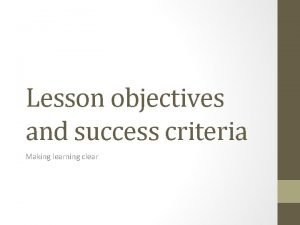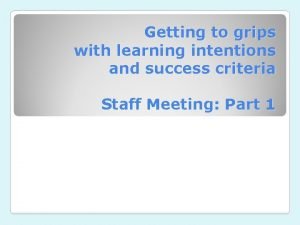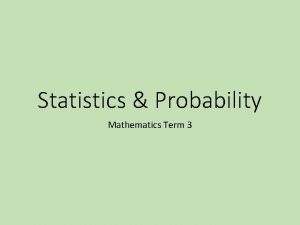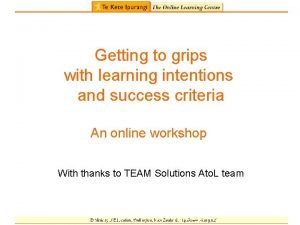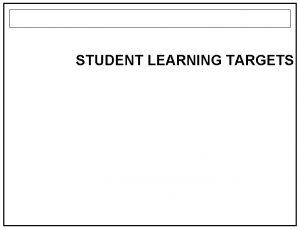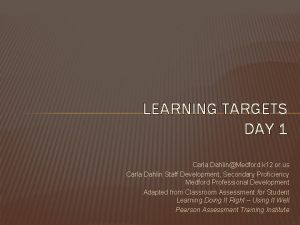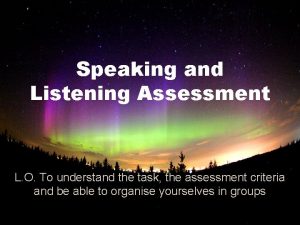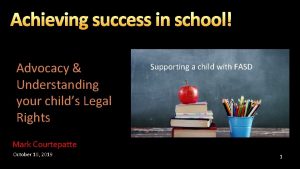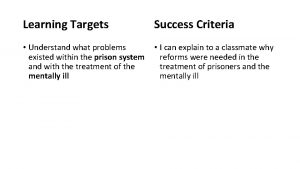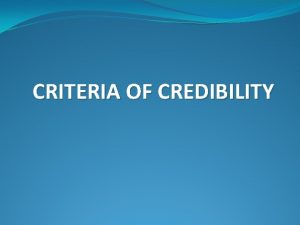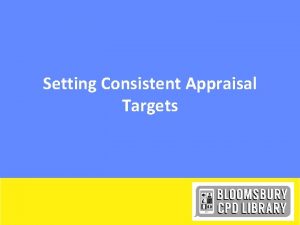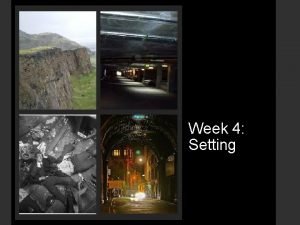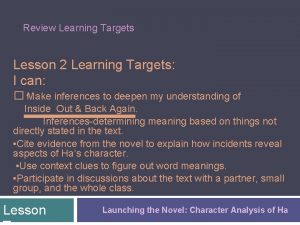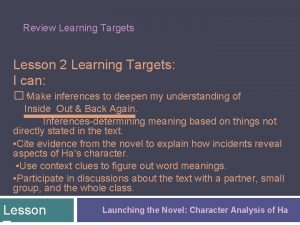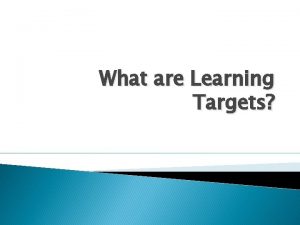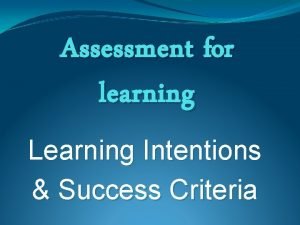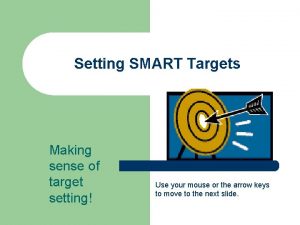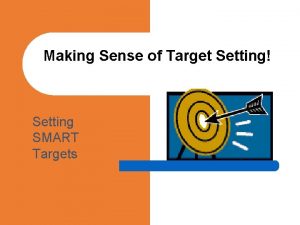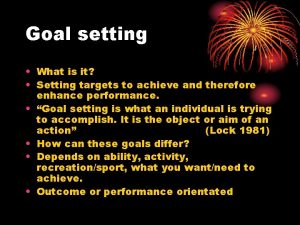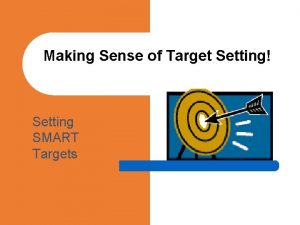Module 4 Success Criteria and Setting Targets Learning















- Slides: 15

Module 4: Success Criteria and Setting Targets Learning outcome #3: Participants will determine appropriate alignment frameworks for connecting departmental mission, goals, outcomes, etc. with those of a higher division or. institution DRAFT Marylee Demeter

Goals: Participants will be able to: Engage in SWOT analysis to guide both planned and emergent change. Plan technology for data management and sharing results of analysis. Consider institutional needs and determine appropriate alignment frameworks for connecting departmental mission, goals, outcomes, etc. with those of a higher division or institution. Department • Mission • Vision • Goals • Outcomes Division • Mission • Vision • Goals • Outcomes Institution • Mission • Vision • Goals • Outcomes

Linking Departmental Missions, Goals, Outcomes, and Plans to the Institutional and Divisional Level: The Importance of Strategic Plans Why link to Strategic Plans (SP)? • Sets priorities for departmental outcomes • Maps a starting point and checkpoints of progress towards outcomes

Planned Change vs. Emergent Change Planned change • Intentional • Improve organizational processes • Rooted in data/evidence (science!) • Directed from higher levels of management • Smaller institutions Emergent change • “Loosely coupled” institutions • Multiple autonomous subunits • Constant adaptation to changing conditions • Identify patterns/themes across initiatives • Improvement within and across the Division

Terminology (Blaisdell & Chamberlain, 2015). • Mission: what the organization does • Vision: what the organization wants to be • Outcomes: expected observable behaviors and actions that results from intentional experience.

Terminology (Blaisdell & Chamberlain, 2015). • Tactics: Short-term focus • Strategies: Long-term focus – overarching efforts to achieve goals • Actions: how to accomplish strategies/objectives; demonstrates progress • Actions >> Strategies >> Goals • Goals: what to achieve (see module 6, LO 1) • Objectives: measurable steps > progress towards goals

Step 1: SWOT Analysis Objective: 1) identify how areas that perform well can be adapted to meet unmet needs 2) plan for improvement in areas that are struggling Environmental scan • Strengths • Weaknesses • Opportunities: growth, development, improvement) • Threats: internal/external • SMART Goals • Participation across departments/levels • Gather data: wide range of information • National and local surveys • Focus groups • Existing data

Data Management: Considerations • Is there a university software system in place to manage processes? • Easy data entry? • Integration with other existing data systems? • Reporting capacity • Work smarter, not harder!

Collaborative Teams: General Principles • Clear purpose/expectation • Broad representation: diverse perspectives, ability to implement change. • Open Communication • Explicit mechanisms for implementation: who will review and approve plans?

Reporting • Fall > Winter • Establish checkpoints • Present plans, collect feedback • Revise and implement • Summer • Progress reports • Note changes in plans during cycle • Explain plans not undertaken • Review assessment data • Review and revise plans • Communicate plans, results, changes etc. throughout university (see Module 5).

Challenges/Sticky points • Organizational Culture • Divisional Leadership/Support • Commitment; changes in staff • Data collection/management • Attitudes towards technology • Redundancy

Tips for Success • Clarify priorities in a flexible manner to enable departments to interpret how they relate to functional areas. • Identifies performance gaps at divisional and departmental levels and focus on improvement • Provide a shared framework • Eliminates redundancy • Identifies opportunities for collaboration

Suggested Frameworks/Resources: Choose what works for your institution • • CAS (Program Outcomes, Administrative/Departmental Outcomes) CAS L&D Outcomes (Student) Bloom’s (affective, psychomotor, cognitive) Student Bloom’s Revised – Iowa State (Factual, conceptual, procedural, metacognitive) Student FALDOs ($35) (Student) VALUE Rubrics (Student) ASK Standards and ASK Need Assessment – (Administrative, Staff Professional Development) Free for ACPA members ACPA NASPA Professional Competency Rubrics - Revised: AER Competency (Administrative, Staff Professional Development) Free Download

Module activity • Conduct SWOT Analysis • Facilitator suggestions welcome! • Use as class activity, informal formative assessment

Resources • Blaisdell, S. & Chamberlain, T. (2015). Tenet eight: Connect assessment plans to institutional and divisional goals. In R. Phillips-Bingham, D. Bureau, A. Garrison. Duncan, & M. Bresciani-Ludvik (Eds. ), Leading Assessment for Student Success: Tenets that Change Culture and Practice in Student Affairs. (pp. 123138). Stylus Publishing. Questions to consider:
 Learning objectives and success criteria
Learning objectives and success criteria Learning intentions and success criteria examples
Learning intentions and success criteria examples Learning intentions and success criteria examples
Learning intentions and success criteria examples Learning intentions and success criteria for mathematics
Learning intentions and success criteria for mathematics Learning intention examples
Learning intention examples Writing learning targets
Writing learning targets Learning targets
Learning targets Forensic science learning targets
Forensic science learning targets Knowledge targets examples
Knowledge targets examples Learning targets knowledge, reasoning, skill product
Learning targets knowledge, reasoning, skill product Learning target
Learning target Speaking and listening assessment
Speaking and listening assessment Your child's success or lack of success
Your child's success or lack of success Your child's success or lack of success
Your child's success or lack of success Process success criteria
Process success criteria Animal shape poems
Animal shape poems
